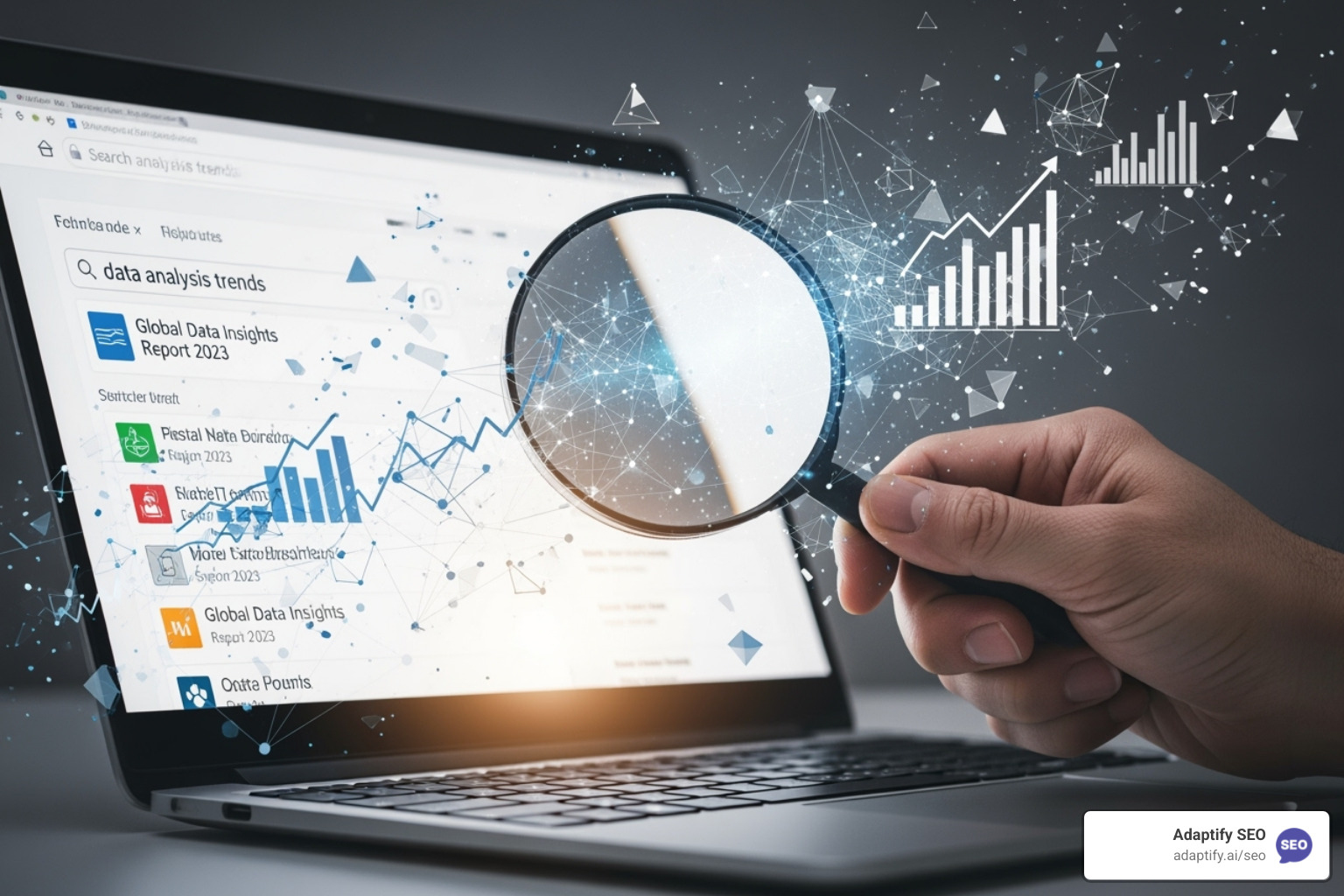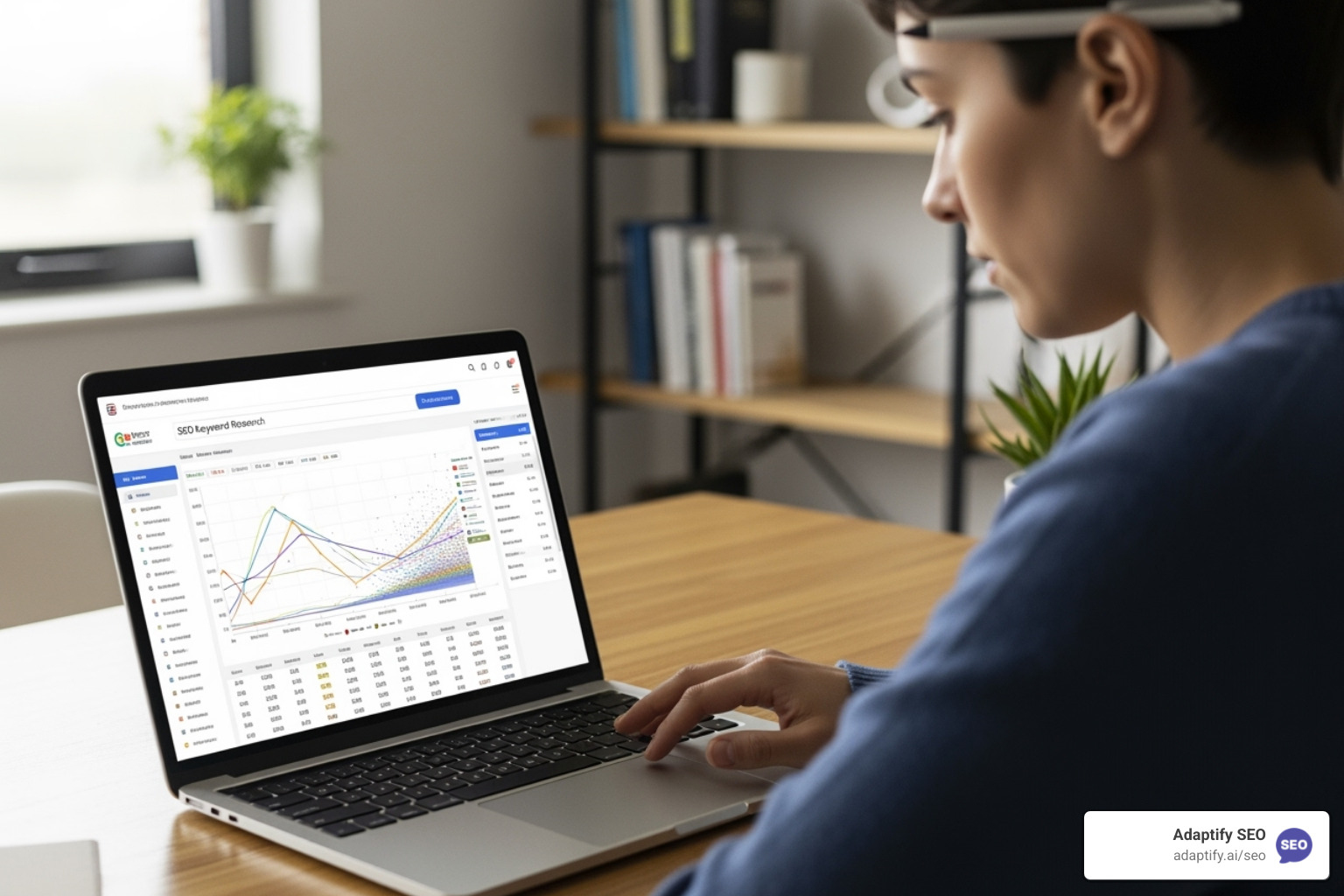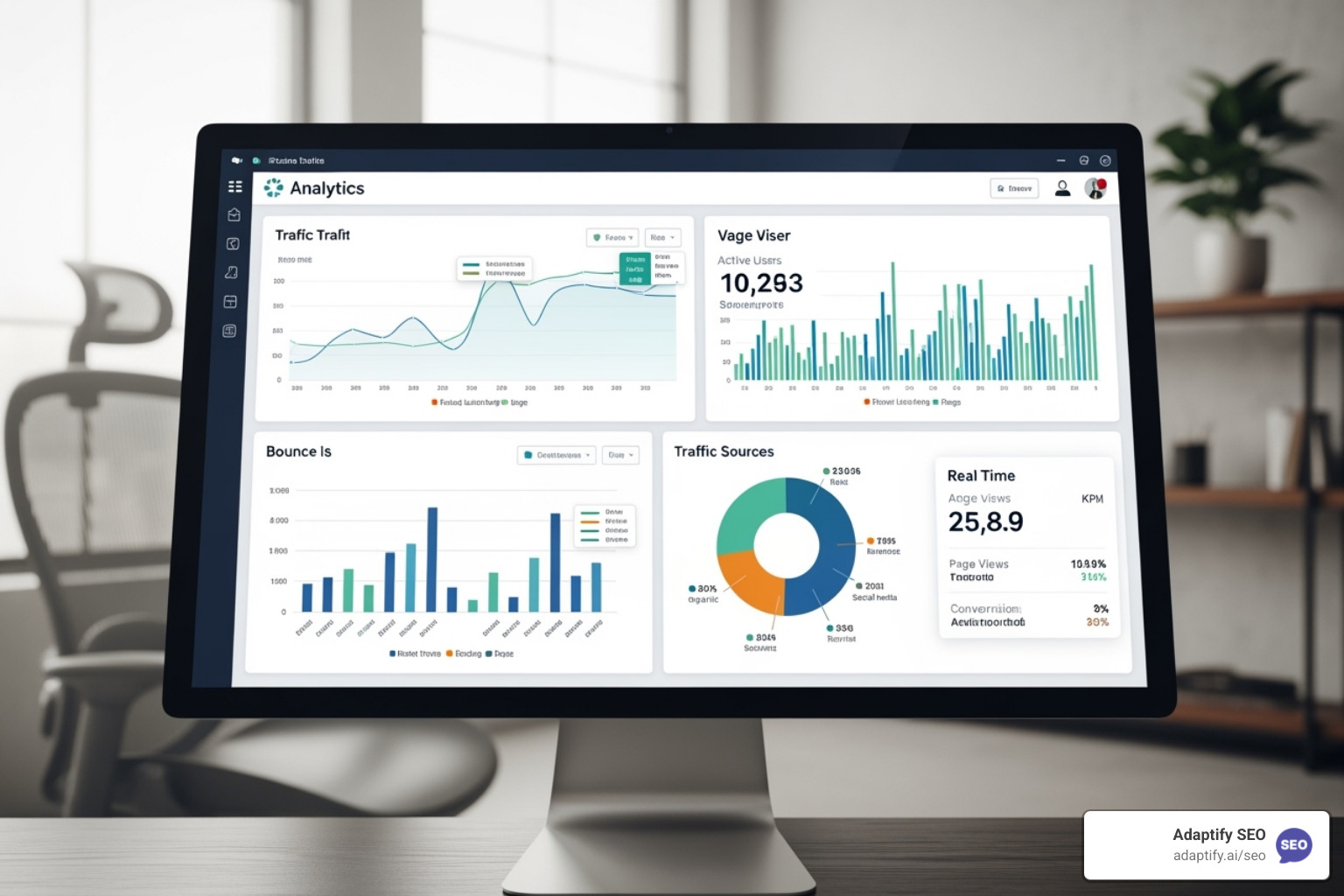Optimize Your Website: A Simple Guide to Better Search Rankings
Hansjan Kamerling
Oct 29
Why Search Optimization is Essential for Your Website's Success

To search optimize your website is to open up sustainable online growth. At its core, search optimization (SEO) is the practice of improving your site's visibility in search results to attract more qualified traffic without paying for ads.
Quick Answer: How to Search Optimize Your Website
- Research keywords your audience uses.
- Create high-quality content that answers user questions.
- Optimize technical elements like page speed and mobile-friendliness.
- Build authority with quality backlinks.
- Monitor performance and adapt your strategy.
The numbers are compelling: organic search delivers 53% of all website traffic, and Google processes over 8.5 billion searches daily. With Google holding 91% of the search market, your visibility directly impacts your success.
This guide will walk you through the pillars of SEO, providing practical strategies to help you climb the search rankings. I'm Hansjan Kamerling, and my experience with SaaS platforms and AI startups has taught me what truly moves the needle in search optimization.
What is Search Optimization and Why Does It Matter?
Search engines are like digital librarians, sifting through billions of pages to find the best answer to a user's query. This process involves three key stages:
- Crawling: Search engine "spiders" follow links to find new and updated content across the web. As Google's Gary Illyes says, "MAKE THAT DAMN SITE CRAWLABLE." If crawlers can't find your pages, you're invisible.
- Indexing: After crawling, the search engine analyzes your page's content and stores it in a massive database called the index. This is where your site waits to be found.
- Ranking: When a user performs a search, algorithms analyze the index to find the most relevant and authoritative pages, ranking them in the search results.
Understanding these fundamentals is crucial. If your site isn't crawlable or your content isn't clearly indexed, all other optimization efforts are wasted. For a deeper dive, Google's official SEO starter guide is an excellent resource.
The Difference Between SEO, SEM, and PPC
Let's clarify these common marketing terms:
- SEO (Search Engine Optimization): Earning traffic through unpaid, organic search results.
- PPC (Pay-Per-Click): Buying traffic by paying for ads, like Google Ads, that appear at the top of search results.
- SEM (Search Engine Marketing): The umbrella term that includes both SEO and PPC.
Here's a quick comparison:
| Feature | SEO (Organic) | PPC (Paid) |
|---|---|---|
| Cost | Time and resource investment | Direct payment per click |
| Speed of Results | Slower (weeks to months) | Immediate |
| Long-Term Sustainability | Sustainable, compounding value | Stops when you stop paying |
I often tell clients that PPC is like renting—it works as long as you pay. SEO is like buying a house—it requires an upfront investment but builds lasting equity.
Why SEO is a Crucial Investment
SEO is no longer just another marketing tactic; it's essential. The industry is projected to reach $122.11 billion by 2028 because it delivers real, measurable value.
SEO's power lies in its long-term value. Unlike paid ads, a well-optimized page can attract visitors for months or years. It also builds brand authority, positioning you as an expert when you consistently appear in top search results. Most importantly, SEO drives qualified traffic—people actively searching for the solutions you provide.
At Adaptify SEO, we've seen this impact clients across the US, UK, and Australia. Our automated approach helps agencies deliver these results efficiently. If you want to learn how we can scale your SEO efforts, check out more info about our SEO services.
The bottom line: SEO builds a sustainable foundation for long-term business growth.
Mastering On-Page SEO: Content, Keywords, and User Intent

On-page SEO involves optimizing the elements on your website that you have direct control over. Think of it as organizing your storefront to be appealing and easy to steer. Content is king in SEO; even a technically perfect site will fail if its content doesn't meet user needs. As noted in Search Engine Land's SEO Periodic Table, content quality is a critical success factor.
The Foundation: Keyword Research and Intent Mapping
Before writing, you must understand what your audience is searching for. This involves brainstorming customer problems, analyzing competitors to find opportunities, and, most importantly, understanding search intent. Is the user looking for information (informational), a specific website (navigational), a product to buy (transactional), or comparing options (commercial)?
Tools like Google's Keyword Planner, Ahrefs, or SEMrush show search volumes, but the real value is in long-tail keywords. A specific phrase like "how to search optimize a local bakery website" has less competition and signals a clearer user need than a broad term like "SEO."
How to search optimize your content for users and search engines
Great content is genuinely helpful to people, not just optimized for bots. Google's algorithms are adept at identifying content written for humans. According to its Search Quality Rater Guidelines, Google values E-E-A-T: Experience, Expertise, Authoritativeness, and Trustworthiness.
Keep your content fresh and ensure it's readable. Use headings, short paragraphs, and lists to break up text and make it scannable. The best content anticipates and answers user questions thoroughly. At Adaptify, our content services are built on this philosophy, creating content that serves audiences while meeting search engine requirements.
Best Practices for Keyword Placement
Strategically place keywords without overdoing it. Focus on these key areas:
- Title Tag: The clickable headline in search results. Include your main keyword and keep it under 60 characters.
- Meta Description: Your 155-character sales pitch in the search results. Include your keyword and a compelling reason to click.
- Header Tags (H1, H2, H3): Use your main keyword in the H1 and related terms in subheadings to structure your content.
- URL: Create clean, descriptive URLs like
yoursite.com/how-to-search-optimize. - Body Content: Weave keywords and synonyms naturally, especially in the first paragraph.
- Image Alt Text: Describe the image accurately and include a keyword if it fits naturally.
Optimizing Images and Videos
Visuals are essential for engagement, but they must be optimized.
- File Names: Use descriptive file names like
chocolate-chip-cookies.jpginstead ofIMG_0047.jpg. - Alt Text: This helps search engines understand images and improves accessibility for users with screen readers.
- Compression: Use tools to compress images without sacrificing quality to ensure fast page loads.
- Video SEO: For platforms like YouTube, optimize titles, descriptions, and tags. Provide transcripts to make your video content searchable.
The key to on-page SEO is to optimize for people first. When you create helpful, well-structured content, rankings often follow.
Beyond the Page: Technical SEO, Authority, and Backlinks

Once your on-page elements are set, it's time to look behind the scenes at technical SEO. This is the foundation of your website; if it's weak, even great content will struggle to rank. Google has made it clear that user experience (UX) is deeply tied to technical SEO. A fast, mobile-friendly, and easy-to-steer site sends strong positive signals to search engines.
Technical tips to search optimize your website's performance
These technical elements are crucial for long-term success:
- Site Speed: Users expect pages to load in under 3 seconds. Google uses site speed as a ranking factor, and its Core Web Vitals measure real-world user experience related to loading, interactivity, and visual stability. Use tools like Google's Lighthouse or GTmetrix to audit performance.
- Mobile-First Indexing: Google primarily uses the mobile version of your site for ranking. A poor mobile experience can make you invisible to a majority of users.
- Crawlability: Your robots.txt file tells search engines which parts of your site to access. An XML sitemap provides a roadmap of all your important pages, helping ensure they get indexed.
- Clean URL Structure: Descriptive URLs like
yourdomain.com/seo-guide/technical-seoare better for users and search engines than generic ones likeyourdomain.com/page?id=123.
Enhancing Visibility with Schema Markup and Rich Snippets
Schema markup is code that helps search engines understand the meaning and context of your content. Using the vocabulary from Schema.org, you can tell Google that a string of numbers is a product price or that a piece of text is a recipe ingredient.
When implemented correctly, this structured data can result in rich snippets in search results—improved listings that include star ratings, FAQs, or event details. These stand out from plain blue links, which can significantly improve your click-through rate.
Building Authority with Backlinks
If on-page SEO is what you say about yourself, backlinks are what others say about you. These links from other websites act as votes of confidence. However, not all backlinks are equal.
Link quality is far more important than quantity. A single link from a respected, relevant industry site is more valuable than dozens of links from low-quality sources. Focus on earning links by creating content so valuable that others naturally want to reference it—such as original research, helpful tools, or comprehensive guides.
Anchor text, the clickable text in a link, gives search engines context about the linked page. Over time, earning high-quality backlinks builds your site's overall domain authority and trustworthiness, a metric popularized by tools like Moz and Ahrefs.
At Adaptify, our backlink services focus on earning valuable links that boost your site's credibility and rankings without resorting to risky tactics.
How to Search Optimize for Long-Term Success

SEO is not a one-time task; it's an ongoing process of refinement and adaptation. The digital landscape is always changing, with Google making hundreds of algorithm updates annually. To search optimize for the long term, you must measure performance and remain agile.
Measuring and Monitoring SEO Performance
SEO is highly measurable. Track these key metrics to gauge your success:
- Organic Traffic: The number of visitors arriving from unpaid search results. Track this in Google Analytics.
- Keyword Rankings: Your position in search results for target keywords. Google Search Console and Bing Webmaster Tools provide this data directly.
- Click-Through Rate (CTR): The percentage of users who click your link after seeing it in search results. A high CTR suggests compelling titles and descriptions.
- Bounce Rate: The percentage of visitors who leave after viewing only one page. A high bounce rate may indicate a mismatch between content and user expectations.
Establish a routine to monitor these metrics, checking weekly for active campaigns and monthly for overall trends.
Common SEO Mistakes to Avoid
Across the US, UK, and Australia, I've seen businesses make the same preventable mistakes:
- Keyword Stuffing: Forcing keywords into content unnaturally. This creates a poor user experience and can lead to penalties. Write for humans first.
- Duplicate Content: Having identical or very similar content on multiple pages (or copied from other sites) confuses search engines and dilutes ranking potential.
- Thin Content: Pages with very little content that offer no real value to the user. Focus on creating comprehensive, helpful resources.
- Buying Links: Paying for links is a violation of Google's guidelines and can result in severe penalties.
- Poor User Experience: Slow load times and non-mobile-friendly designs hurt rankings, especially with mobile-first indexing.
The Future of SEO: AI and Emerging Trends
The search landscape is evolving rapidly, driven by AI. Google's Search Generative Experience (SGE) and AI Overviews are changing how users get information, often providing direct answers instead of just links. This requires a shift toward Generative Engine Optimization (GEO), optimizing content to be understood and used by AI systems.
Other key trends include:
- Voice Search: Optimizing for conversational, question-based queries.
- Visual Search: Using tools like Google Lens means optimizing images is more critical than ever.
- Search Experience Optimization (SXO): Considering the entire user journey, which may span multiple platforms.
- Other Search Platforms: Users, especially younger demographics, increasingly use platforms like TikTok and Amazon for search. A modern strategy must look beyond Google.
Staying ahead of these trends provides a significant competitive advantage.
Frequently Asked Questions about Search Optimization
Here are answers to the most common questions I receive from clients looking to search optimize their websites.
How long does it take to see results from SEO?
SEO is a marathon, not a sprint. While anyone promising overnight results is likely misleading you, a realistic timeline depends on factors like competition, your budget, and your website's starting authority. For most businesses, you can expect to see initial results in 4-6 months. A brand new site may take 6-12 months to see significant gains. Local SEO can often yield results faster, typically within 2-3 months, due to a smaller competitive landscape.
What is the difference between on-page and off-page SEO?
Think of it like owning a house. On-page SEO is everything you do on your property to improve it—the content, keywords, site structure, and HTML tags. You have full control over these elements. Off-page SEO is your reputation in the neighborhood—factors outside your site that signal its authority. This primarily includes backlinks from other sites, but also brand mentions and social signals. Both are essential for a successful SEO strategy.
Is SEO something I can do myself?
Yes, DIY SEO is possible, especially when you're starting out. Learning the basics is a great way to understand the fundamentals of how search works. Many excellent guides are available online that cover keyword research, content optimization, and basic technical fixes.
However, SEO can become complex. Advanced technical issues, competitive content strategies, and effective link building often require specialized expertise and a significant time commitment. This is where professional agencies and advanced tools like SEMrush, Ahrefs, or Moz can accelerate results. At Adaptify SEO, our AI-powered automation handles the heavy lifting, allowing you to scale your efforts efficiently and compete at a higher level.
My advice is to start with the basics, but don't hesitate to seek professional help when you're ready to scale.
Conclusion
We've covered the essentials of how to search optimize your website, from on-page content and technical foundations to off-page authority and future trends. SEO is not just a marketing tactic; it's a fundamental pillar for sustainable business growth, connecting you with customers at the exact moment they need you.
The work you do today builds on itself, creating lasting value. As the digital landscape evolves, the power of automation in SEO is becoming critical, especially for agencies managing multiple clients. Repetitive tasks can be streamlined, freeing you to focus on strategy and results.
Adaptify.ai streamlines SEO implementation, handling everything from strategy and content creation to PR link building with AI that adapts to search engine changes. This allows agencies in the US, UK, Australia, and beyond to deliver significant results with greater efficiency. You can find more info about our white-label services at https://adaptify.ai/seo/overview/white-label, perfect for agencies looking to scale their offerings.
The fundamentals of SEO remain the same: create value, optimize for users and search engines, and build authority. The journey to the top of the search rankings starts now.
Ready to see how our automated SEO solutions can revolutionize your agency's workflow?
